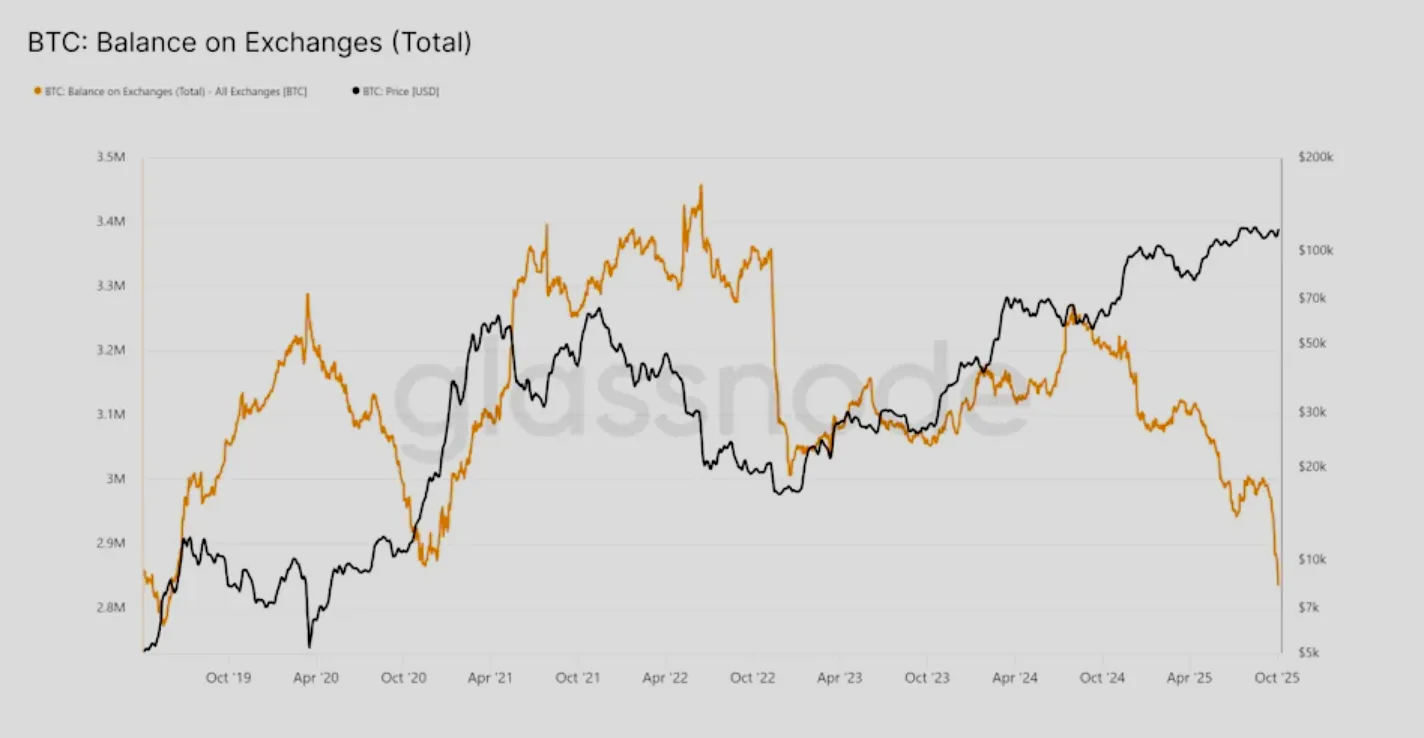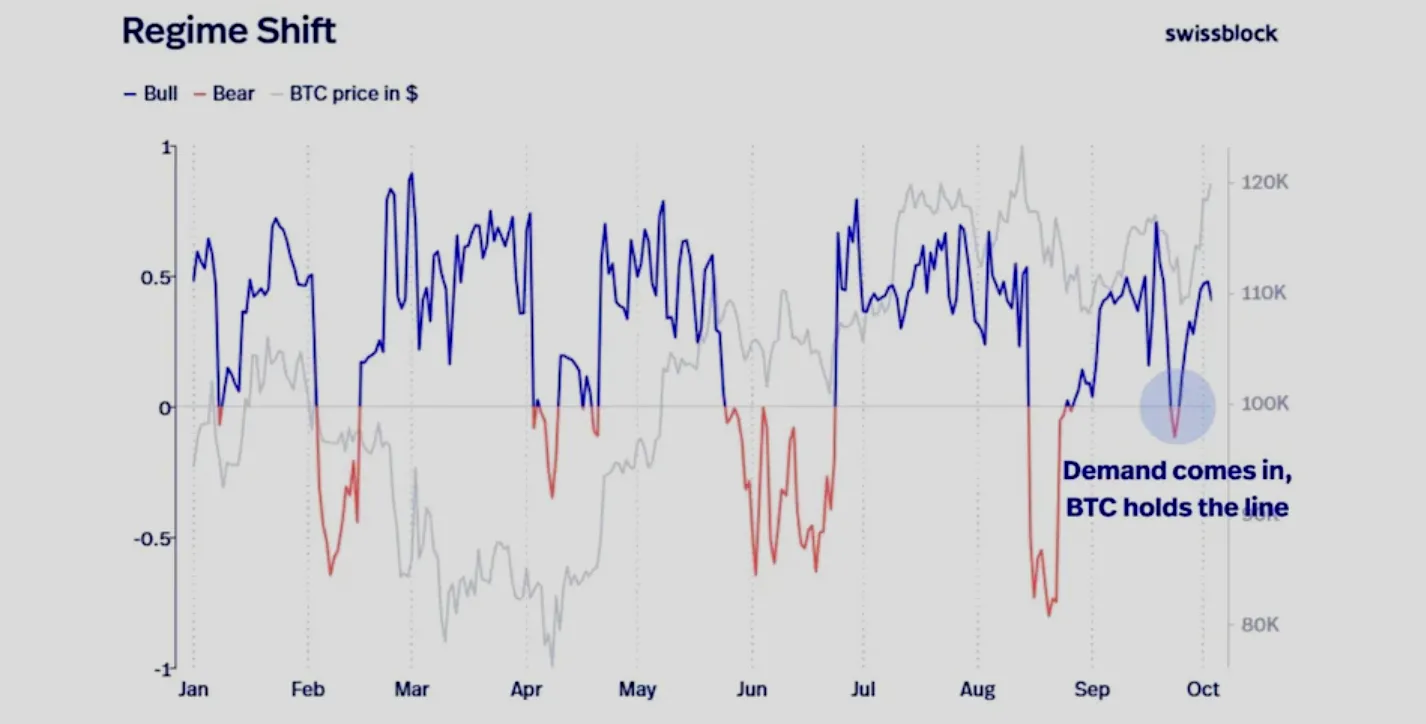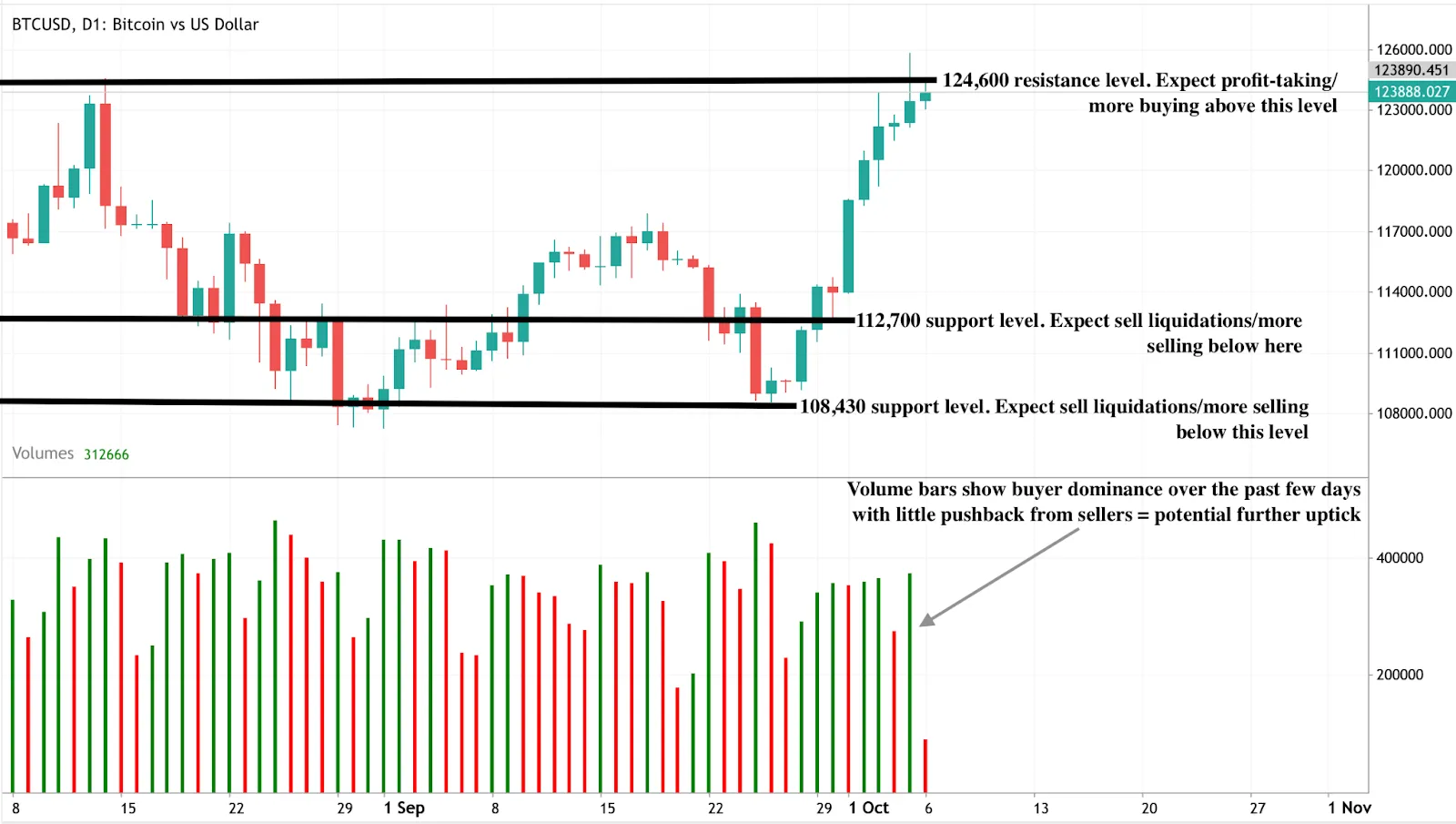Upungufu wa usambazaji wa Bitcoin umevunjika hadi $125K mnamo 2025

Kupanda kwa Bitcoin juu ya $125,000 inaashiria makutano ya nguvu nyingi za kupanda - usambazaji unazimarisha, kuongezeka kwa uingizaji wa taasisi, na ujasiri mpya wa wawekezaji kati ya uhakika wa kiuchumi duniani Pamoja na idadi ya sarafu kwenye ubadilishaji sasa katika kiwango cha chini cha miaka sita na “biashara ya kupunguza” inakua kasi, mkutano wa hivi karibuni wa Bitcoin unaonyesha upungufu wa miundo na kuhamisha mtiririko wa mtaji kwenye mali za dijiti. Bado, maswali yanabaki juu ya ikiwa hatua hiyo inaenea moja kwa moja hadi $150K au husimama kwa ujumuishaji kwanza.
Vidokezo muhimu
- Bitcoin ilifikia kiwango kipya cha juu cha wakati wote karibu na $125,700 wakati wa kikao cha Jumapili cha Oktoba 5 cha Asia - kuinua kiwango chake cha soko hadi $2.5 trilioni - juu ya Amazon na kufunga fedha.
- Salio ya ubadilishaji umeshuka hadi BTC milioni 2.83, ya chini zaidi katika miaka sita, ikiashiria mkusanyiko wa mwekezaji wa muda mrefu.
- Uingizaji wa taasisi kwenye ETF za crypto na miliki ya hazina yanasaidia mahitaji endelevu.
- Wachambuzi wanaonyesha “biashara ya kupunguza” - mahitaji yanayoongezeka kwa Bitcoin wakati wawekezaji huzuia deni, mfumuko wa bei, na udhaifu wa dola.
- Kuongezeka kwa idadi na shinikizo la kupungua kwa uuzaji zinaonyesha nguvu ya muundo, sio
- $120K bado ni kiwango muhimu cha bei kwa kudumisha kasi ya muda wa kati.
Uhaba wa usambazaji wa Bitcoin husaidia kuongeza viwango vya juu
Kupanda kwa Bitcoin hadi kiwango kipya cha juu cha wakati wote karibu $125,400 inaashiria wakati muhimu katika historia yake ya miaka 17. Tofauti na mikutano ya zamani, ongezeko hili haliendeshwa kimsingi na kujiinua au uongozi wa uvumi. Ubadilishaji data kutoka CoinGlass na Swissblock inaonyesha kuwa usambazaji wa BTC unaopatikana kwa biashara umeshuka hadi sarafu milioni 2.83 tu, kiwango cha chini kabisa tangu 2019.

Mchanganyiko huu inamaanisha sarafu chache zinapatikana kwa kuuza hata wakati mahitaji yanapoongezeka - kuunda usanidi wa kawaida wa thamani ya bei. Mkusanyiko na wamiliki wa muda mrefu na fedha za taasisi umeongeza kwa kasi usambazaji wa soko tangu Septemba, na kusaidia Bitcoin kupona kutoka kwa kushuka wake wa awali chini ya $110K.
Kwa wafanyabiashara wanaotafuta kutumia mabadiliko haya, biashara ya Bitcoin kwenye Deriv inatoa fursa za kutazama juu ya harakati za bei bila kumiliki mali ya msingi - inayopatikana kote MT5 Derive na Deriv Trader majukwaa.
Unyunzaji wa mahitaji na imani halisi ya
Kulingana na Kiashiria cha Bull Bear cha Swissblock, mkutano wa Bitcoin unaungwa mkono na mahitaji halisi, sio uvumi wa muda mfupi. Hata wakati wa kujiondoa, shinikizo la ununuzi limezidi uuzaji mara kwa mara. Kiwango cha Shift cha Muundo wa kampuni - kipimo cha imani ya mwenendo - ilibaki juu wakati wa marekebisho, ikionyesha soko linaloendeshwa na mkusanyiko, sio kuongezeka.

Shughuli za taasisi zimekuwa kichocheo kingine. Tangu katikati ya mwaka, uingizaji kwenye ETFs za crypto na ugaji wa hazina umepanua sana, huku wasimamizi wakubwa wa mali wakiongeza kufichua kati ya msimamo rafiki wa udhibiti nchini Marekani.
Biashara ya kupunguza Bitcoin inachukua hatua kuu
Wachambuzi wa JPMorgan wanaelezea mazingira ya sasa kama “biashara ya kupunguza,” ambapo wawekezaji wa rejareja na taasisi huzuia hatari ya sarafu na usawa wa fedha kupitia mali kama dhahabu na Bitcoin.
Hadithi hiyo inasaidiwa na:
- Kuongezeka kwa deni la serikali na dhiki ya fedha nchini Marekani na Ulaya.
- Dola dhaifu ya Marekani huongeza nguvu ya kiasi ya Bitcoin.
- Kuongezeka kwa uhakika wa kijiografia, kutoka uchaguzi wa kimataifa hadi mabadiliko ya sera.
Pamoja, mambo haya yameongeza mvuto wa Bitcoin kama duka la thamani mbadala - au, kama wachambuzi wanavyoandaa, “dhahabu ya dijiti.”
Kwa muktadha, mienendo kama hiyo imekuwa ikiendesha gari mvuko wa hivi karibuni wa dhahabu na upya maslahi ya mabadiliko ya soko la mafuta - zote mbili zinaonyesha mahitaji ya mwekezaji kwa mali halisi katika mazingira ya deni kubwa.
Uingizaji wa Bitcoin ETF kutoka taasisi pia ni dereva
Mabadiliko katika sera ya Marekani chini ya utawala wa Trump - ikiwa ni pamoja na kupitishwa kwa bili tatu zinazounga mkono wa crypto katikati ya 2025 - yamechochea ujasiri katika masoko ya kifedha. Wawekezaji wa taasisi wamejibu na uingizaji wa rekodi kwenye ETF mpya zilizinduliwa za crypto, wakati hazina za kampuni zimeanza kutibu Bitcoin kama mali ya hifadhi ya muda mrefu.
Mabadiliko haya katika muundo yamepunguza tabia ya uvumi wa soko. Tofauti na mnamo 2021, wanunuzi wa leo ni washiriki wa muda mrefu zaidi, na kusababisha msingi wa mahitaji thabiti na ugonjwa wa chini kwa kila kitengo cha kiasi.
Upinzani wa kiufundi na viwango vya msaada
Wakati wa kuandika, bei ya BTC inaondoka kwenye kiwango cha upinzani cha $124,600, ikiashiria kubadilishwa kwa bei inayowezekana. Walakini, baa za kiasi zinaonyesha shinikizo kubwa la ununuzi na kushughulikia muuzaji kidogo, ikipendekeza uwezekano wa kupanda zaidi
Ikiwa kupungua kwa upinzani kusababisha kurudi nyuma, Bitcoin inaweza kupata msaada karibu na $112,700 na $108,430 - viwango vinavyoingana na maeneo ya awali za ujumuishaji na riba ya ununuzi wa taasisi.

Kwa wafanyabiashara wanaofuatilia viwango hivi vya kiufundi, Deri kikokotoo cha biashara inaweza kusaidia kukadiria faida inayowezekana, upande, na maadili ya pip katika aina tofauti za akaunti.
Mtazamo wa soko na hali za bei
Ikiwa salio za ubadilishaji bado yanabaki ngumu na uingizaji wa ETF unaendelea, Bitcoin inaweza kujaribu $150K kwa muda wa kati. Walakini, kupungua kwa muda mfupi kuna uwezekano huku wafanyabiashara hutoa faida na kutathmini tena nafasi.
- Kesi ya kupanda: Uingizaji unaendelea wa taasisi, mazingira thabiti ya kiwango, na usambazaji wa chini wa ubadilishaji unaweza kusukuma BTC kuelekea $150K mwishoni mwa mw
- Kesi isiyo ya kawaida: Kipindi cha ujumuishaji kati ya $120K—$130K, kinaonyesha utumbo wa soko baada ya kuthamini haraka.
- Kesi ya Bearish: Mapumziko chini ya $120K ingeashiria kasi ya kupungua, ingawa mahitaji makubwa ya muundo huzuia hasara zaidi.
Athari za uwekezaji
Kwa wafanyabiashara, usanidi wa muda mfupi unapendelea matumaini makini.
- Muda mfupi: Ikiwa kasi inashikilia, ujumuishaji kati ya $120K na $130K utatoa maeneo ya kupendeza za kuingia.
- Muda wa kati: Uingizaji endelevu wa ETF na usambazaji mdogo unaweza kusababisha harakati kuelekea $140K—$150K ndani ya miezi.
- Sababu za hatari: Kupunguka kwa kasi kwa dola ya Marekani au kushuka kwa ushiriki wa taasisi kunaweza kupunguza kasi.
Wawekezaji wa muda mrefu wanapaswa kutambua kuwa ubadilishaji wa miaka sita ya Bitcoin hutoa pointi za chini kwa soko la kuimarisha kimsingi - muundo ambao kihistoria unatangulia awamu kubwa za up
Biashara ya upungufu wa Bitcoin kwenye majukwaa ya Deriv
Wafanyabiashara wanaotafuta kutumia fursa ya usambazaji wa Bitcoin wanaweza kutumia seti ya zana ya Deriv iliyoundwa kwa kubadilika, kasi, na usahihi katika hali nyingi za soko.
- Biashe CFD za Bitcoin kwenye Deriv MT5, au Deriv Trader ili kutazama juu ya bei zinazoongezeka na kushuka bila kumiliki mali ya msingi.
- Tumia Viongezaji ili kuongeza harakati za bei za muda mfupi huku ukiweka upande wa chini. Hii ni bora kwa biashara ya ndani ya siku wakati wa awamu za kubadilika kubwa.
- Tumia viashiria vya kiufundi kama RSI, MACD, na wastani wa kusonga kwenye Deriv MT5 ili kuthibitisha mwenendo wa kasi juu ya viwango muhimu vya upinzani na usaidizi (mfano, $124,600 na $112,700).
- Unganisha kikokotoo cha biashara cha Deriv na chati za moja kwa moja za crypto kutathmini mpaka, thamani ya pip, na faida inayowezekana kwa kila usanidi wa biashara.
Zana hizi zinaruhusu wafanyabiashara kuendelea usambazaji wa kuimarisha wa Bitcoin na kufaidika kwa ugonjwa, iwe nafasi ya kuendelea kwa $150K au marekebisho ya muda mfupi.
Takwimu za utendaji zilizonukuliwa sio dhamana ya utendaji wa baadaye.



